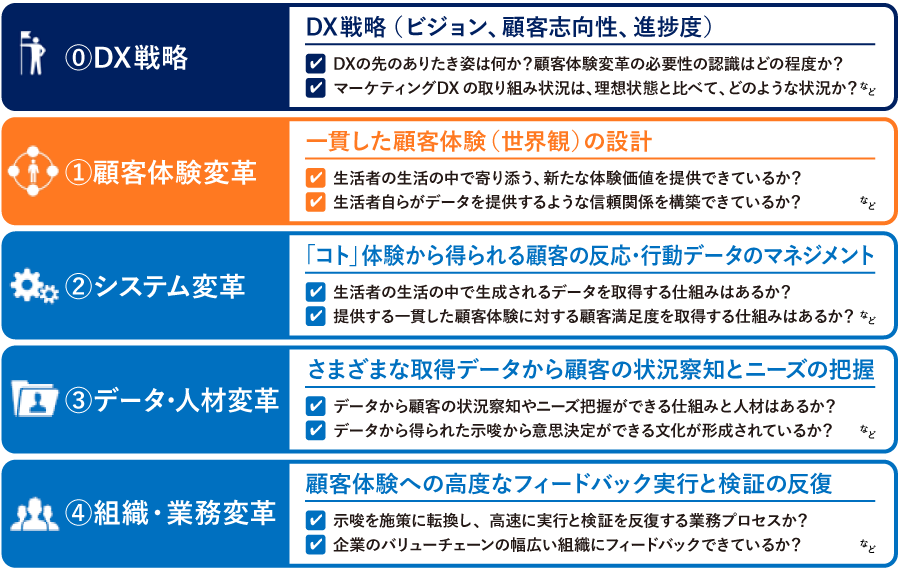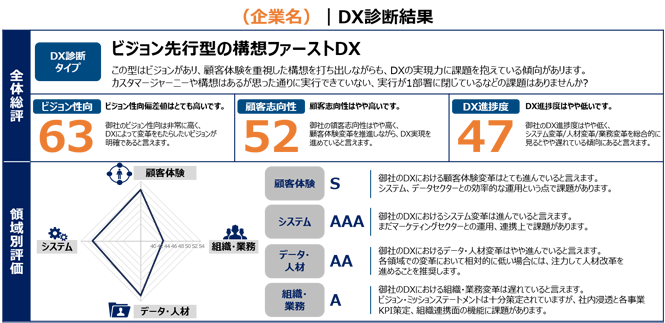Two essential engines for marketing in the DX (Digital Transformation) era: "Data Infrastructure" and "Customer Experience."
Dentsu Inc. has partnered with Treasure Data, provider of Japan's market-leading CDP (Customer Data Platform) "Treasure Data CDP," to secure the "data infrastructure" engine essential for advancing clients' DX.
This time, we spoke with Tsuyoshi Wakahara, Evangelist at Treasure Data, and Shigeta Misawa and Norifumi Watanabe from Dentsu Inc.'s Business Transformation Division, who support business transformation, about the objectives of Dentsu Inc.'s new service, the "Dentsu Digital Transformation Diagnosis," and the current state of DX.
The "DX Diagnosis" Born for More Comprehensive Client Support
──Please tell us about the background behind the creation of the "Dentsu Digital Transformation Diagnosis" (hereafter, DX Diagnosis).
Misawa: Dentsu Inc. is a company with a long history and proven track record in the advertising field. However, to provide even greater support as a marketing partner for our clients, we need to focus on areas beyond advertising.
The Business Transformation Division, where Watanabe and I work, is a department that supports new business transformations like DX. Due to the impact of the pandemic, DX challenges have become apparent for many companies. We aim to use the "DX Diagnosis" as a catalyst to provide comprehensive marketing support.
Watanabe:As Misawa also reported in the Web Dentsu News article, we've heard numerous accounts of companies saying, "We're pursuing DX as a company, but it's not leading to results." Dentsu Inc. also wants to tackle these client challenges. The "DX Diagnosis" is the tool that provides that starting point.
Wakahara: Treasure Data's clients are also grappling with how to transform their businesses while pursuing DX. There's also a need to understand whether they are ahead or behind their competitors. I feel the "DX Diagnosis" is an excellent tool that can provide objective metrics.
Misawa: However, simply using the term "DX" covers too broad a scope, and we want to leverage Dentsu Inc.'s strengths. Therefore, we define the area concerning our clients' customer touchpoints as "Marketing DX" and will focus our support on that specific part.
Wakahara: So, within the broader business transformation domain, the concept of Marketing DX emerged by combining the rising demand for DX with the strengths of Dentsu Inc.
Misawa: Exactly. By creating this specialized field of Marketing DX and consolidating talent there, we can effectively accumulate expertise. This approach allows us to efficiently expand our business domain for both clients and Dentsu Inc.
A unified customer experience is what creates competitive advantage.

Part of the diagnostic items. To analyze clients' DX from multiple angles, we prepared a questionnaire consisting of 32 items across three perspectives and four domains. We quantify and diagnose DX challenges based on clients' responses.
──What exactly is the "DX Diagnosis" tool?
Watanabe: Clients answer 32 questionnaire-style questions, and we generate diagnostic results. We classify companies into 8 types and display evaluations for each metric on a radar chart, making it immediately clear where strengths lie and where growth is lagging.
Wakahara: I reviewed the actual questions and found them very comprehensive. The 32 questions strike a perfect balance, ensuring it's not burdensome for clients.
Watanabe: The evaluation is conducted from four perspectives: "① Customer Experience," "② Systems," "③ Talent," and "④ Organization & Operations." All are essential for creating a unified customer experience.
What Marketing DX should deliver is a customer experience that leverages the company's unique strengths. This customer experience is supported by excellent systems, skilled personnel who can operate them, and appropriate operational design.
We also include questions about the company's mission, vision, and values. DX is a means to improve management and services. To avoid falling into "DX for DX's sake," the company's mission, vision, and values are crucial.
Misawa: Simply adopting a policy of "let's improve the customer experience" can easily lead to individual optimization. As a result, the experience received at the storefront can be completely different from the experience received via the website or email. Returning to the mission/vision/values makes it easier to provide a unified customer experience that embodies the company's "essence."
Wakahara: This is very well thought out and designed. If you only focus on meeting customer needs, it becomes difficult to differentiate yourself from competitors ( ). That's where the company's mission and other core values become the foundation for expressing its unique identity.
DX Implementation Pitfalls by Diagnostic Type

DX diagnosis results are clearly displayed using eight distinct "types" and radar charts for each metric.
──What insights can be gained from the "DX Diagnosis" results?
Watanabe: The eight diagnostic types reveal distinct challenges. For instance, if a company has advanced systems and personnel transformation but lacks customer orientation, Dentsu Inc. would take the lead in aiming to "enhance the customer experience."
Misawa: Companies with low customer orientation often have accumulated data but struggle to implement effective measures. Data accumulation becomes the goal itself, without a clear plan for how the collected data will be used.
Wakahara: I often emphasize that "data that accumulates arbitrarily and data collected with intent are fundamentally different in usefulness, even if they're the same data." Raising awareness about data through the "DX Diagnosis" is very positive. A bird's-eye view is crucial for DX.
Watanabe: Conversely, if the diagnosis shows high customer orientation but low DX progress, the focus should be on "system transformation." For such companies, we can propose solutions leveraging Treasure Data's specialized expertise.
──From Treasure Data's perspective as the provider of "Treasure Data CDP," what are the key points for advancing system transformation?
Wakahara: Even if a client recognizes the need for DX, it doesn't automatically lead to implementing a CDP. First, it's crucial to help them understand that data utilization is important and grasp what it means to collect, integrate, and analyze data.
It's crucial for clients themselves to thoroughly consider data utilization and truly grasp its significance when transforming their systems.
Watanabe: Today, every company considering DX has likely explored implementing a CDP or DMP (Data Management Platform) at some point. However, often these systems aren't implemented at all, or if they are, they're only used in a limited capacity.
Even companies with a strong customer-centric mindset often find their systems lagging behind. Conversely, this type of company can rapidly implement PDCA cycles and execute low-cost, swift initiatives once their systems are properly established.
Wakahara: I think there's a tendency for CDP or DMP implementation itself to become the goal. That's precisely why it's reassuring that the "DX Diagnosis" provides an overview, making the "right place to use CDP" clearer for that company.
Mizusawa: Through the "DX Diagnosis," once you understand what you can and cannot do, the next steps should become clear. In other words, it clarifies the purpose: "Why are we pursuing DX?" and "Why are we implementing a CDP?"
Wakahara: Exactly. While Treasure Data CDP can flexibly incorporate and analyze various data, simply feeding data in without a clear purpose risks getting lost.
Instead, if data utilization progresses based on each company's customer-centric approach ( ), both companies and consumers will benefit, and the value of the "DX Diagnosis" will only increase.
The pandemic era is precisely the moment for transformation.
──How do you see DX evolving from here?
Misawa: Data has become critically important for every company. They need to acquire diverse data at diverse points in time and from diverse touchpoints. From this perspective, I believe many companies require support.
Watanabe: The impact of COVID-19 has been enormous. For example, companies in sectors like manufacturing, which previously had no direct customer contact because they relied on wholesalers, have suddenly seen a surge in demand to connect directly with customers due to the pandemic. Changes are emerging even in industries and operations that had previously shown little movement, such as online business meetings and going paperless.
Wakahara: There's talk about the "2025 Cliff," but now might be the last opportunity to objectively assess your company and implement countermeasures. We encourage you to start by using our "DX Diagnosis" to confirm your current position.
Watanabe: The DX Diagnosis inevitably has sections where answers can be somewhat subjective. If you answer optimistically, you might get a favorable result, but that won't truly benefit your company. By answering sincerely without putting on a front, you should uncover your real challenges. We hope this helps you clearly identify those challenges and become a catalyst for tackling marketing DX in this new era.
If you're interested in the solutions provided through the collaboration between Treasure Data and Dentsu Inc./Dentsu Digital Inc., please feel free to contact us.










